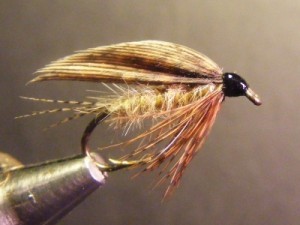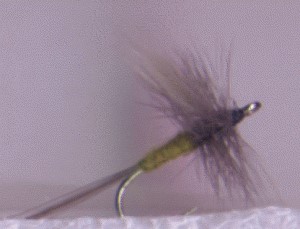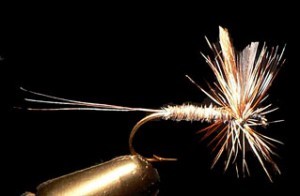Category Archives: Fly Patterns
March Brown Wet
Recipe:
Hook: Mustad 3906 or Equivalent
Size: 10 – 16
Thread: Black
Tail: Dark Ginger Hackle Fibers or Pheasant Tail Fibers
Rib: Yellow Thread
Body: Fawn Fox
Hackle: Dark Ginger Hen Collar Style or Beard Style
Wing: Oak Turkey Quill Segments
Directions: Wrap thread from the eye to the bend and tie in tail material. Tie in a segment of yellow thread and let hang. Apply dubbing and wrap to 1/4 inch behind eye. Spiral yellow thread forward. Tie in hackle and tie it off collar style. Tie in two oak turkey segments across the back of the fly and tie off with a clean head.
Fish this fly across current and down stream allowing it to settle into the current.
TD
Category Archives: Fly Patterns
Hendrickson
The Hendrickson hatch is one of the first major hatches of the season. This year because of the relatively mild winter, the hatch is predicted to take place on or near the opening of the general trout season, April 24.
The Hendrickson has been copied many times and improvised on but always the basic recipe emerges a winner. This pattern came from an old Orvis pattern book I’ve had for many years and have always returned to for it’s patterns.
Recipe:
Hook: Mustad 94840 or equivalent size 12 -18
Thread: Black or gray
Wing: Lemon wood duck, upright and divided
Body: Dark dun dubbing
Hackle: Dark dun rooster hackle
Tail: Dark dun hackle fibers
Directions:
Begin by tying a base of thread a third of the way back from the eye. Tie on the wing consisting of lemon wood duck fibers and divide it. (On smaller size hooks a clump will suffice as long as it spreads) Wrap back to the bend and tie on a few dark dun hackle fibers for the tail and begin dubbing dark gray squirrel, muskrat, beaver material or poly (your choice) forward to the wing and beyond. Tie in one or two (depending on the size hook) dry fly hackle feathers and wind behind and in front of the wing. Create a head and tie off.
See you on the water!
TD
Category Archives: Fly Patterns
Parachute Sulfur
This pattern is designed to imitate an emerging sulphur sitting on top of the water in the film with their wings not quite dry. When the hatch is on, these are like candy. These also go by the name of Light Hendrickson’s.
Recipe:
Hook: Mustad 94840 or Equivalent
Size: 10 – 18
Thread: Cream
Wing: White Calf Tail Tied Upright or a Light Turkey Body Feather clumped
Tail: Dark Cream / Light Dun Hackle Fibers
Body: Cream Fur or Poly
Hackle: Dark Cream Tied Around Posted Wing
Directions: Tie in the wing 1/3 of the way back of the eye in a post. Tie in the tail. Dub sparsely and wrap up to and forward of the wing. Tie in the hackle and wrap around the post 3 – 4 times and tie off.
Fish this in the film during a hatch and get ready.
Category Archives: Fly Patterns
Adams
The Adams pattern is perhaps the dean of all mayfly patterns. This fly has evolved into variations and used on most rivers throughout the country. It is a staple.
Recipe:
Hook: Mustad 94840 or equivalent
Size: 10 – 20
Thread: Gray
Wings: Grizzly Hackle Tips – Upright and Divided
Tail: Brown and Grizzly Hackle Fibers Mixed
Body: Muskrat or Medium Gray Poly
Hackle: Brown and Grizzly Mixed
Directions: Select two grizzly hackle tips and tie them in upright and divided. Wrap the thread back to the bend and tie in the tail. Prepare the dubbing and wrap it sparsely to the wing. Tie in the hackle and wrap behind and ahead of the wing, mixing the brown and grizzly hackle. Tie off with a head.
This fly is a common imitation of a mayfly and is used throughout the season. It is a Michigan fly that is fished all over.
Category Archives: Fly Patterns
Hendrickson Wet
Give them a try when you see sporadic dark mayflies hovering over the water and can’t get a strike on a dry.
Recipe:
Hook: Mustad 3906 or equivalent
Size: 10 – 14
Thread: Gray
Tail: Medium Dun Hackle Fibers
Body: Muskrat Fur Dubbing
Hackle: Medium Dun Hen – Collar Style
Wing: Lemon Wood Duck
Directions: Weight in not a consideration. By that I mean the fly is meant to be fished under the surface but not bouncing along like a nymph so lead wire is not necessary. Neither is lightness a consideration. Begin by starting the thread at the eye and wrap to the bend and tie in the tail. (A small clump.) Apply the dubbing and create the body, do so in a cigar shape. Wrap the hackle pinching it back collar style when you tie it off and tie on a clump of lemon wood duck fibers over the top of the fly like deer hair on a caddis. Tie off the head cleanly. (No hackle beyond it.)
TD
Category Archives: Fly Patterns
Pheasant Tail Wet
This is a great wet fly that can be used to imitate many hatches. It is also serves as a good attractor pattern.
Recipe:
Hook: Mustad 3906
Size: 10 -16
Thread: Brown
Tail: Mahogany Ringneck Pheasant Center Tail Fibers
Rib: Fine Copper Wire
Body: Same Ringneck Tail Fibers as Tail
Hackle: Brown Partridge Hackle – Collar Style
Directions: Wrap thread back to the bend and tie on tail. Tie in the copper wire and body material and wrap the body forward and tie off. Spiral copper wire forward and tie off. Tie in hackle and tie off collar style. Finish with a clean head.
Note: The partridge hackle is the key to this fly. The abundant soft hackle protruding all the way to the tail is what makes this fly affective,
Category Archives: Fly Patterns
Matuka
I have found that the Matuka, if fished in fast water, is one of the most productive streamers I have in my box. I use it on the Jordan in a section where there are riffles. When fished cross current, it is deadly as the streamer straightens. There are several variations in color
These flies are not easy to tie because of putting four hen hackle feathers together for the top and tail of the fly, but once you get comfortable matching the feathers, it becomes easier.
Recipe:
Hook: Mustad 9672 or Mustad 38941
Size: 2 – 10
Thread: Match Yarn Color
Rib: Fine Oval Gold Tinsel
Body: Red, Olive, Gray or Yellow
Wing: 4 Hen Hackles – Badger for Red Body / Olive for Olive Body / Grizzly for Gray body/ Furnace for Yellow Body
Hackle: To Match Wing
Directions: The only difficult step to tying this fly is selecting 4 hen hackles that match. Everything else is straight forward. Tie in the yarn and tinsel behind the eye and wrap the thread back to the bend. Leave 4 inches of thread hanging and wrap the tying thread forward to just behind the eye. Wrap the yarn toward the eye, leaving enough space for the hackle. (this should result in a cigar shaped body). Match the 4 hen hackle feathers and trim off the bottom half of the feather so the feather sits on tip of the fly from the eye to the bend. The feathers should extend beyond the bend to form the tail. Tie the feather in at the bend with the 4 inches of thread you left and spiral it forward to create gaps in the feather and tie both the thread and hackle in just behind the eye. It should look like a dorsal fin that extends from the eye beyond the bend. Bring the gold tinsel forward following the spiral path set with the thread and tie off. Behind the eye tie in the hackle, wrap three or four turns and tie off forming a head.
Experiment with body colors and match the wing to the color. A red body uses a furnace wing; a gray body uses a grizzly wing; a yellow body uses a dark wing.
This is my go to fly when everything else fails.
Category Archives: Fly Patterns
CDC Dunn
This simple pattern puts to use the cul-de-canard feathers which are found next to a ducks preen gland. These feathers are translucent and make great wings especially on smaller flies. They are impregnated with the ducks natural oils which makes them extremely floatable.
Recipe:
Hook: Light Wire Dry Fly
Thread: Olive
Tail: Blue Dun Hackle Fibers
Wing: Natural Gray Cul-De-Canard Feather
Body: Olive Dubbing
Hackle: Blue Dun
Directions: Wrap a base of thread then tie on CDC feathers upright, divided and slightly angled back. Wrap back to the bend and tie on the tail, dividing the fibers into two directions by creating a ball of thread then tying the fibers on each side. Apply dubbing and wrap forward creating a thorax around the wing. Tie on the hackle and tie off with a clean head.
Note: This pattern is simple and can be tied quickly. Tie different sizes and different shades to imitate most mayflies.
Category Archives: Fly Patterns
BWO
This pattern is a must anytime of year. The difference is in the size. Have these in your fly box on the opener in sizes 14 – 18.
Recipe:
Hook: Standard Dry Fly Hook 12 – 20
Thread: Olive
Wing: Dark Dun Hackle Tips / Upright and Divided
Tail: Dark Dun Hackle Fibers
Body: Medium Olive Fur or Poly
Hackle: Dark Dun
Directions:
One quarter of the way back to the bend tie on the wing tips, upright and divided. Wrap thread back to the bend and tie in the hackle fibers for the tail. Prepare the dubbin on the thread and wrap forward to the wing. Remove the web portion of one or two dry fly hackle and tie them in beyond the wing and wrap behind, through and forward of the wing. Tie off and form head and finish. Add a drop of cement.
On opening weekend, watch for these to hatch and be especially aware of their size. Rainy weather can see this hatch come off the water. Also, tie these parachute style and use dubbing sparingly.
Category Archives: Fly Patterns
Borcher
If I were restricted to one mayfly pattern, I’d use the Borcher. It was developed for the Au Sable, Manistee and Boardman rivers. It is possibly the most generic of all mayfly patterns.
Recipe:
Hook: Standard Dry Fly Hook
Size: 12 – 18
Thread: Gray
Wings: Lt. Dun Hackle Tips – Upright and Divided
Tail: Mahogany Ringneck Pheasant Tail Fibers
Rib: Gold Wire
Body: Oak Turkey Wing Quill Fibers or Stripped Hackle Stems
Hackle: Brown and Grizzly Mixed
Directions: I like to begin by tying in the wings and dividing them. Then wrap the thread to the bend and tie in the tail. Tin in the body material (either the turkey wing quill fibers or the stripped hackle stem)and the rib. Wrap the body material to the wings and spiral the rib to the wings. Tie in the hackle and wrap behind the wing and forward. Create a head.
Note: The tail is extra long in three segments.










